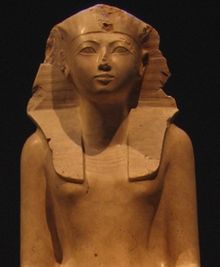Winner of the Fall 2016 StMU History Media Award for
Best Introductory Paragraph
Article with the Best Title
Queen B said it best when she sang the infamous line, “Who run the world? Girls.”1 When looking back to history, men are seen as better and treated better than women. A long time ago, in ancient Egypt, women of the royal family served as guides to young male rulers. But there was one unconventional case where a woman defied the odds and obtained the role of pharaoh.

Queen Hatshepsut was the oldest daughter of Thutmose and his Great Royal Wife, Queen Ahmose. Thutmose, like most males who held power during those times, had another wife with whom he had a son. His name was Thutmose II; when he was at the age of eight and Hatshepsut was thirteen, they were wed, despite the fact of their shared blood line. When their father passed, Thutmose II assumed the position of pharaoh. While he was pharaoh, they birthed a daughter, but every male in power needs a male heir. Since she was unable to produce a son, he and a minor wife, Iris, conceived a son who became Thutmose III. Thutmose II and Hatshepsut reigned in Egypt until his death. The next male in line was Thutmose III, but Hatshepsut’s step child was too young to fulfill the position of pharaoh, so she ruled in his stead. On that note, even when he did become old enough to rule, she refused to turn over the power to him, and she remained in power. That is when she began her transition from Queen Hatshepsut to Pharaoh Hatshepsut.2

The Queen herself had a headdress made that included a beard and some male characteristics.3 She did not go out of her way to keep her gender a secret, for she did include feminine touches to her attire. Masculinity of course was respected more and was associated with power, which is why she sometimes took on such characteristics. Despite being a female ruler, at that time (and still today) people would not expect such a flourishing reign. Beginning in 1473 B.C.E. and ending in 1458 B.C.E., under her control wealth was accumulated. When it came to the protection of Egypt, she engaged in successful warfare against her invaders. She also had an extensive building program in which a temple of devotion to their sun god, Amun, was erected. Prosperity and wealth also came about because she sent ships on expeditions to foreign lands to obtain riches. These included ivory, ebony, gold, and trees. Now, why would they bring back trees? Whenever they had temple ceremonies, trees would be burned by the tons for fragrant incense.4
All good things must come to an end, and this particular ending is death. After she died, successors attempted to erase the fact that a female had become pharaoh.5 Even with this attempt to erase history, she is still known as a successful pharaoh to this day. She brought about protection, prosperity, and plenitude during her time as king. She did not serve as a guide to a young male pharaoh, but she showed how one must rule during her reign.
- Beyoncé, “Run the World (Girls),” in 4, Columbia Records, 2011. ↵
- Ann Macy Roth, “Models of Authority: Hatshepsut’s Predecessors in Power,” in Hatshepsut: From Queen to Pharaoh, ed. Catharine H. Roehrig, Renee Dreyfus, and Cathleen A. Keller (New York: Metropolitan Museum of Art, 2005), 10. ↵
- Roth, “Models of Authority: Hatshepsut’s Predecessors in Power,” 10. ↵
- Rupert Matthews, DK Eyewitness Books: Explorer (DK Publishing, 2012), 8. ↵
- Angela Murock Hussein, “Legacy of a Female Pharaoh,” Calliope 19, no. 1 (September 2008): 48. ↵



85 comments
Josselyn Arrieta-Meraz
I love this article and the amount of women empowerment it carries. The fact that she would dress up with men features at times shows the fact that she had to prove herself to others on how women can be as successful as men. Pharaoh Hatshepsut was a warrior and a perfect example of what women can do in a leadership position, not only does it give it that modern twist to a past event but it gives you hope for the future.
Zeresh Haman
This is an amazing and even inspiring story. Hatshepsut was able to attain a great amount of power and respect in a time that was mostly dominated by men. I think its interesting how she understood and acknowledged that she would gain more respect if she looked like a man. I really think its awesome that she was able to attain great wealth and prosperity, that just helped prove that a woman could be pharaoh. It is unfortunate that after her death they tried to erase her from history, I’m really glad that they were unsuccessful because now we have a strong female figure in ancient times to look and learn from.
Rebekah Esquivel
I love this introduction! It was both funny and informative, I love that you started it with lyrics from a strong female figure in our society today. It definitely got my attention from the start. I had never heard of Queen Hatshepsut and it was very interesting to read about how she became a pharaoh. I would think they would find someone else in the group to rule instead of resulting to having a woman. However, I am sure they were very surprised and learned a lot when she was actually able to rule just as good as the men. I think it is very interesting how she added male characteristics to her headdress but also put in her female characteristics as to not hide her gender. This was a very informative article and I would love to learn more about this Queen.
Osman Rodriguez
Awesome article! I actually have never heard of Pharaoh Hatshepsut. She sounds like a very interesting figure in Egyptian history. I would actually like to know more about her and her accomplishments. I still find it interesting how and what royal families would do to keep their lineage in power. I think the fact that she took over as Pharaoh was interesting and how she wouldn’t give it up once her stepson was of age.
Brianda Gomez
Who run the world? Girls! I love this intro, it really caught my attention. Queen Hatshepsut broke all rules and stereotypes. I really enjoyed reading this article because the queen took power from a man (her brother). In my opinion, she was brave to become queen, no matter the opinion of other people. It is somewhat sad and disappointing that she had to take on some masculine characteristics to be respected and be more associative with power
Amanda Figueroa
This article was very well written and explained the reign of Queen Hatshepsut perfectly. I find it very astonishing at the fact that she remained in power even though Thutmose III was already old enough to rule. This shows her bravery, since a female king was not common at all. The Beyoncé reference really grabs everyone’s attention as it grabbed mine for sure.
Maria Callejas
Amazing title choice! It instantaneously shows the power of Queen Hatshepsut. As well, your introduction is genius. You add a mainstream reference that really sets the stage for Queen Hatshepsut’s significance. Great usage of facts! It does make the story come to life. Particularly when you explained how Hatshepsut integrated masculine characteristics to her attire, as it was associated with power. Overall great writing! It is incredible to see strong female leaders existed during those times.
Alexandria Martinez
This was a wonderful article and very well written, I like the comparison between the song and Hatshepsut. It is true that women are very capable in doing what men can do, some women can even do it better, and in the case of Hatshepsut it was very clear that she was very qualified for the job. It means something when people try to erase history but it just won’t go away, and in this case it means that she was a great pharaoh.
Abigale Carney
Great article! Love the Beyonce song lyric in the beginning! I love reading stories such as this where the women are powerful, and make a great impact on their society. When she refused to turn the power over to her step son, it showed how strong of a woman she was. Women in those days would never refuse the wishes of a man, and it is inspiring to read stories like this about Queen Hatshepsut because she helped shape women into the way we are today.
Thomas Fraire
Queen Hatshepsut, is absolutely and amazing article. Its really cool that there was a female ruler in a time where that was completely taboo. Its even more amazing that she was a good ruler and she took care and defended her people. It’s also really messed up of people trying the strip her legacy after she was gone, I mean this women gave her life for her people and they didn’t even have the decency to try and preserve her memory.